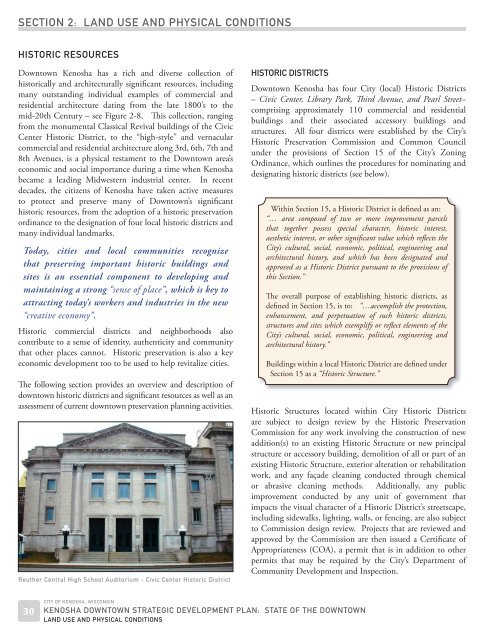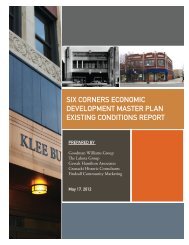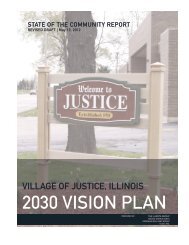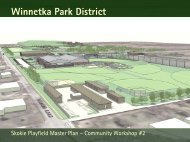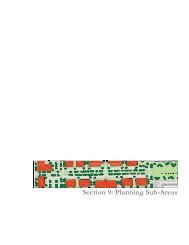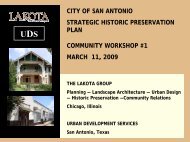Kenosha State of Downtown Report.indd - The Lakota Group
Kenosha State of Downtown Report.indd - The Lakota Group
Kenosha State of Downtown Report.indd - The Lakota Group
You also want an ePaper? Increase the reach of your titles
YUMPU automatically turns print PDFs into web optimized ePapers that Google loves.
SECTION 2: LAND USE AND PHYSICAL CONDITIONS<br />
HISTORIC RESOURCES<br />
<strong>Downtown</strong> <strong>Kenosha</strong> has a rich and diverse collection <strong>of</strong><br />
historically and architecturally significant resources, including<br />
many outstanding individual examples <strong>of</strong> commercial and<br />
residential architecture dating from the late 1800’s to the<br />
mid-20th Century – see Figure 2-8. This collection, ranging<br />
from the monumental Classical Revival buildings <strong>of</strong> the Civic<br />
Center Historic District, to the “high-style” and vernacular<br />
commercial and residential architecture along 3rd, 6th, 7th and<br />
8th Avenues, is a physical testament to the <strong>Downtown</strong> area’s<br />
economic and social importance during a time when <strong>Kenosha</strong><br />
became a leading Midwestern industrial center. In recent<br />
decades, the citizens <strong>of</strong> <strong>Kenosha</strong> have taken active measures<br />
to protect and preserve many <strong>of</strong> <strong>Downtown</strong>’s significant<br />
historic resources, from the adoption <strong>of</strong> a historic preservation<br />
ordinance to the designation <strong>of</strong> four local historic districts and<br />
many individual landmarks.<br />
Today, cities and local communities recognize<br />
that preserving important historic buildings and<br />
sites is an essential component to developing and<br />
maintaining a strong “sense <strong>of</strong> place”, which is key to<br />
attracting today’s workers and industries in the new<br />
“creative economy”.<br />
Historic commercial districts and neighborhoods also<br />
contribute to a sense <strong>of</strong> identity, authenticity and community<br />
that other places cannot. Historic preservation is also a key<br />
economic development too to be used to help revitalize cities.<br />
<strong>The</strong> following section provides an overview and description <strong>of</strong><br />
downtown historic districts and significant resources as well as an<br />
assessment <strong>of</strong> current downtown preservation planning activities.<br />
Reuther Central High School Auditorium - Civic Center Historic District<br />
HISTORIC DISTRICTS<br />
<strong>Downtown</strong> <strong>Kenosha</strong> has four City (local) Historic Districts<br />
– Civic Center, Library Park, Third Avenue, and Pearl Street–<br />
comprising approximately 110 commercial and residential<br />
buildings and their associated accessory buildings and<br />
structures. All four districts were established by the City’s<br />
Historic Preservation Commission and Common Council<br />
under the provisions <strong>of</strong> Section 15 <strong>of</strong> the City’s Zoning<br />
Ordinance, which outlines the procedures for nominating and<br />
designating historic districts (see below).<br />
Within Section 15, a Historic District is defined as an:<br />
“… area composed <strong>of</strong> two or more improvement parcels<br />
that together possess special character, historic interest,<br />
aesthetic interest, or other significant value which refl ects the<br />
City’s cultural, social, economic, political, engineering and<br />
architectural history, and which has been designated and<br />
approved as a Historic District pursuant to the provisions <strong>of</strong><br />
this Section.”<br />
<strong>The</strong> overall purpose <strong>of</strong> establishing historic districts, as<br />
defined in Section 15, is to: “…accomplish the protection,<br />
enhancement, and perpetuation <strong>of</strong> such historic districts,<br />
structures and sites which exemplify or refl ect elements <strong>of</strong> the<br />
City’s cultural, social, economic, political, engineering and<br />
architectural history.”<br />
Buildings within a local Historic District are defined under<br />
Section 15 as a “Historic Structure.”<br />
Historic Structures located within City Historic Districts<br />
are subject to design review by the Historic Preservation<br />
Commission for any work involving the construction <strong>of</strong> new<br />
addition(s) to an existing Historic Structure or new principal<br />
structure or accessory building, demolition <strong>of</strong> all or part <strong>of</strong> an<br />
existing Historic Structure, exterior alteration or rehabilitation<br />
work, and any façade cleaning conducted through chemical<br />
or abrasive cleaning methods. Additionally, any public<br />
improvement conducted by any unit <strong>of</strong> government that<br />
impacts the visual character <strong>of</strong> a Historic District’s streetscape,<br />
including sidewalks, lighting, walls, or fencing, are also subject<br />
to Commission design review. Projects that are reviewed and<br />
approved by the Commission are then issued a Certificate <strong>of</strong><br />
Appropriateness (COA), a permit that is in addition to other<br />
permits that may be required by the City’s Department <strong>of</strong><br />
Community Development and Inspection.<br />
30<br />
CITY OF KENOSHA, WISCONSIN<br />
KENOSHA DOWNTOWN STRATEGIC DEVELOPMENT PLAN: STATE OF THE DOWNTOWN<br />
LAND USE AND PHYSICAL CONDITIONS


